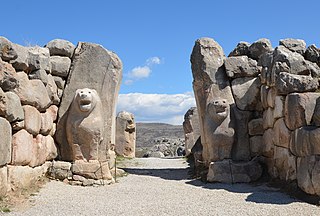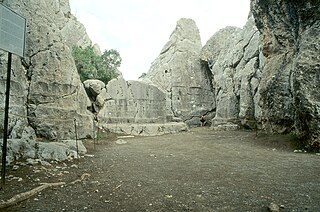Hattush may refer to:
Hattush may refer to:

The Hittites were an Anatolian Indo-European people who formed one of the first major civilizations of Bronze Age West Asia. Possibly originating from beyond the Black Sea, they settled in modern day Turkey in the early 2nd millennium BC. The Hittites formed a series of polities in north-central Anatolia, including the kingdom of Kussara, the Kanesh or Nesha kingdom, and an empire centered on Hattusa. Known in modern times as the Hittite Empire, it reached its peak during the mid-14th century BC under Šuppiluliuma I, when it encompassed most of Anatolia and parts of the northern Levant and Upper Mesopotamia.
Hittite may refer to:
Hatti may refer to

Hittite, also known as Nesite, is an extinct Indo-European language that was spoken by the Hittites, a people of Bronze Age Anatolia who created an empire centred on Hattusa, as well as parts of the northern Levant and Upper Mesopotamia. The language, now long extinct, is attested in cuneiform, in records dating from the 17th to the 13th centuries BC, with isolated Hittite loanwords and numerous personal names appearing in an Old Assyrian context from as early as the 20th century BC, making it the earliest attested use of the Indo-European languages.

The Hattians were an ancient Bronze Age people that inhabited the land of Hatti, in central Anatolia. They spoke a distinctive Hattian language, which was neither Semitic nor Indo-European. Hattians are attested by archeological records from the Early Bronze Age and by historical references in later Hittite and other sources. Their main centre was the city of Hattush. Faced with Hittite expansion, Hattians were gradually absorbed into the new political and social order, imposed by the Hittites, who were one of the Indo-European-speaking Anatolian peoples. The Hittites kept the country name unchanged, which also became the main designation for the Hittite state.

Hattusa, also Hattuşa, Ḫattuša, Hattusas, or Hattusha, was the capital of the Hittite Empire in the late Bronze Age during two distinct periods. Its ruins lie near modern Boğazkale, Turkey, within the great loop of the Kızılırmak River.
Hattic may refer to:

Šuppiluliuma II, the son of Tudḫaliya IV, was the last certain great king of the New Kingdom of the Hittite Empire, ruling c. 1207–1178 BC, contemporary with Tukulti-Ninurta I of the Middle Assyrian Empire. The name of the king, unlike that of his ancestor Šuppiluliuma I, is usually spelled Šuppiluliama in the contemporary primary sources.

Yazılıkaya was a sanctuary of Hattusa, the capital city of the Hittite Empire, today in the Çorum Province, Turkey. Rock reliefs are a prominent aspect of Hittite art, and these are generally regarded as the most important group.
Lions' Gate, Lion Gate or similar terms may refer to:

Hittite mythology and Hittite religion were the religious beliefs and practices of the Hittites, who created an empire centered in what is now Turkey from c. 1600–1180 BC.
Boğazköy can refer to the following places:
Kurunta was younger son of the early 13th century BC Hittite king Muwatalli II and cousin of Tudhaliya IV. Kurunta was thereby a Hittite prince and king of Tarhuntassa country. It has been suggested that he may have captured the Hittite capital for a very short time during the reign of the Hittite king Tuthaliya IV and declared himself a great king.
The Kaska were a loosely affiliated Bronze Age non-Indo-European tribal people, who spoke the unclassified Kaskian language and lived in mountainous East Pontic Anatolia, known from Hittite sources. They lived in the mountainous region between the core Hittite region in eastern Anatolia and the Black Sea, and are cited as the reason that the later Hittite Empire never extended northward to that area. They are sometimes identified with the Caucones known from Greek records.

Sapinuwa was a Bronze Age Hittite city at the location of modern Ortaköy in the province Çorum in Turkey about 70 kilometers east of the Hittite capital of Hattusa. It was one of the major Hittite religious and administrative centres, a military base and an occasional residence of several Hittite kings. The palace at Sapinuwa is discussed in several texts from Hattusa.

Nerik was a Bronze Age settlement to the north of the Hittite capitals Hattusa and Sapinuwa, probably in the Pontic region. Since 2005–2009, the site of Nerik has been identified as Oymaağaç Höyük, on the eastern side of the Kızılırmak River, 7 km (4.3 mi) northwest of Vezirköprü.

Šamuḫa is an ancient settlement near the village of Kayalı Pinar, c. 40 km west of Sivas, in the Sivas Province of Turkey. Located on the northern bank of Kizil Irmak river, it was a city of the Hittites, a religious centre and, for a few years, a military capital for the empire. Samuha's faith was syncretistic. Rene Lebrun in 1976 called Samuha the "religious foyer of the Hittite Empire".
Ḫattušili was the regnal name of three Hittite kings:

Hittite cuneiform is the implementation of cuneiform script used in writing the Hittite language. The surviving corpus of Hittite texts is preserved in cuneiform on clay tablets dating to the 2nd millennium BC.

Hapalla, also written as Haballa, was a kingdom in central-western Anatolia during the Late Bronze Age. As one of the Arzawa states, it was a sometime vassal and sometime enemy of the Hittite Empire.